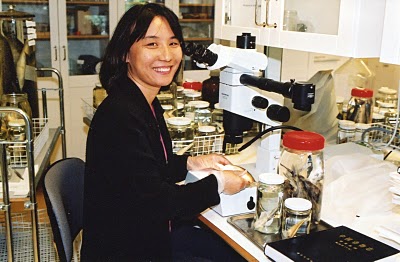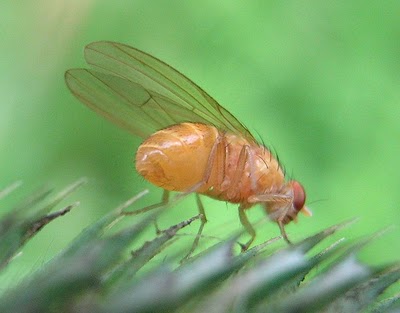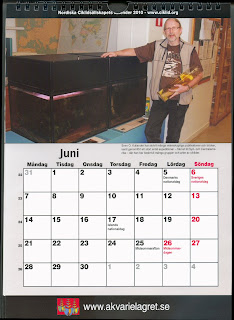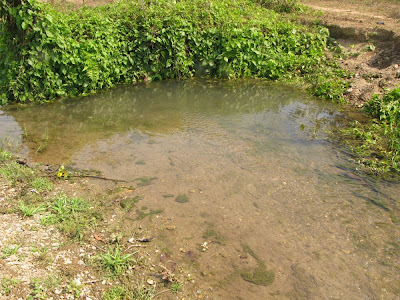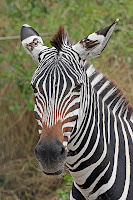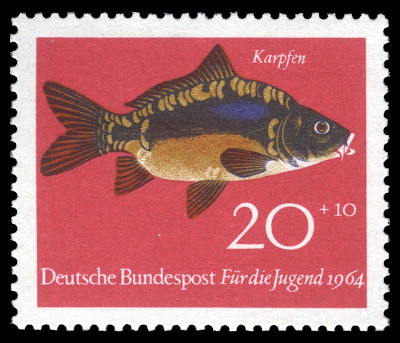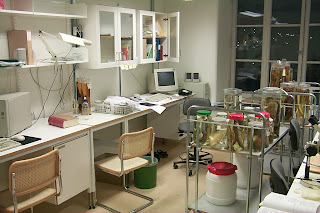 My friend Ralf Britz (Dracula fish), just released the description of a species related to the Dracula fish (Danionella dracula), viz., the Penis fish (Danionella priapus), which is number four in the genus (D. mirifica, and D. translucida were described earlier). This was a bit of of concern to me. Is the evolution of Danionella Nature’s idea of a freak show (or a Japanese game show…)? Or perhaps the fishy Fantastic Four (Bloodsucker, Flasher, Beauty, and Invisible). By the way, there is a Marvel character called Priapus.
My friend Ralf Britz (Dracula fish), just released the description of a species related to the Dracula fish (Danionella dracula), viz., the Penis fish (Danionella priapus), which is number four in the genus (D. mirifica, and D. translucida were described earlier). This was a bit of of concern to me. Is the evolution of Danionella Nature’s idea of a freak show (or a Japanese game show…)? Or perhaps the fishy Fantastic Four (Bloodsucker, Flasher, Beauty, and Invisible). By the way, there is a Marvel character called Priapus.
Danionella priapus, the male holotype. Photo (c) Ralf Britz, reproduced with kind permission.
The penis, a worm-shaped intromittent reproductive organ characterizing mammals, some reptiles and very few birds, has fascinated male ichthyologists for a long time. The typical penis, in placental mammals, contains some spongy tissue and ducts for urine and sperm. Many species of fish with various elongate reproductive structures have been named with reference to the penis, or after the Greek minor deity commonly associated with an oversize penis (list below). The only group of fish that had escaped until 2008 were the Chondrichthyans, equipped with the most penis-like intromittent organ among fishes, known as mixipterygia and a synapomorphy of the group. Perhaps because in Chondrichthyans, the male reproductive organ, a modifiction of the pelvic fin, is paired. Yes, they have two. Theoretically a male shark could mate with two females simultaneously, but there seems to be no observation of such act and perhaps for reason that such pairing must be very complicated to coordinate, no other vertebrates invested in double external reproductive organ. But we all do maintain a paired internal set, except that in many fishes there is only one ovary. Marsupials, it must be added, are an exception here as in so many other respects. Males usually have a bifurcate penis unfit for peeing with and consequently used only for copulation. Females have two vaginas (with common opening), each with its own uterus, and a third for parutition.
In actinopterygian fish, sperm-transmitting elongate structures, intromittent organs, are technically known as gonopodium (live bearing poeciliids), or andropodium (Hemiramphidae; Goodeidae) in livebearers and are formed by modifications of anal-fin rays. Egglaying fish are commonly equipped with a genital papilla through which sperm or eggs are released. The genital papilla of females is sometimes referred to as the egg-laying tube or ovipositor. It is very impressive in bitterlings in which it is used for depositing eggs deep inside bivalves. None of these terms were considered suitable for a fish name, however.
What about naming fish after mammal female external reproductive organs? There is the south Asian
Trypauchen vagina Schneider, 1801, a goby, for which Schneider did not explicitly explain the etymology but gave the local name, obviously based on information from the collector/correspondent in Danish India (Tranquebar), Christoph Samuel John (1747-1813), “
Sewwöli, i.e., vagina cultri rubra, Tamulice”, what would mean: “
Sewwöli, that is, red knife slide, of the Tamils”, i.e., nothing to do with humans. It is a slender, caudally tapering fish with a predominantly red colour. Schneider gave the same name also, spelled
Sewwöti, for
Cepola coecula (junior synonym of another goby,
Taenioides anguillaris), another slim, red fish. There are also Thai cyprinids
Probarbus labeamajor and
P. labeaminor, named by Tyson Roberts in 1992, but for the thick and thin lips, respectively, of the mouth.
 Trypauchen vagina
Trypauchen vaginaPriapos was an ancient Greek god of fertility, usually depicted with an oversize, erect penis, and according to Lemprière a rather deformed figure, not worthy of residing in the Olympics, and on the whole more of a rapist and rascal than anything else, requiring sacrifice in the form of of asses (Equus africanus, that is). This sad figure seems eventually to have converted into a garden gnome in Western garden culture. In Rome, Mutunus was the approximate equivalent. There is no fish named for Mutunus.
Interestingly, a very large number of fish possess a well developed genital papilla. In cichlids, for instance, it is long and pointed in males, but short and swollen, with at least a transverse fold in females, although there is variation, and in some genera it is hard to tell males and females apart on the papilla alone. Cottids are also well known for the long male genital papilla, as exemplified by Phallocottus, and it is also prominent in gobioids, but I could not find any relevant name in that group. The group that have most of the penile names are the livebearing poeciliids, in which the anal fin is modified to an elongate intromittent organ.
Back to Fantastic Four. As Ralf points out, these miniature fishes, and other miniatures as well, are remarkable not only for their small size. They also have conspicuous novel characters which gain significance particularly in a small body. The elongate fangs of Danionella dracula are the only oral tooth structures known from cypriniforms, and may very well be the beginning of a radically different evolutionary lineage. Males of Paedocypris (another miniature), and D. priapus have developed accessory sexual organs not known from other cyprinids, and may be actively evolving in organs that larger, more long-lived fish with longer generation times cannot afford to invest in.
Small size apparently calls for radical solutions, and those radical solutions may be the matter of evolutionary leaps. We are accustomed to think, at least I am, of evolution among fishes being based on something mid-sized rather normal fusiform, which then strikes off in different feeding niches, becoming smaller or larger depending on energy householding. But, that does not seem to lead to much real diversity (after all, all cichlids and cyprinids look very much the same). Radical morphological change as within Danionella may be one of the clues to evolutionary stepping. Most striking about species of Danionella is that they are so radically different from each other. Had they been a few centimeters longer, they would probably have been placed in different genera, but now they are considered as specialized close relatives. So, there is something important to be learned from the penis fish and friends.
Not all small fish present novel characters or behaviour, but the phenomenon seems to be particularly evident in progenetic species. This is then seen clearly in the larvae of many marine fishes in particular. The amazing spinature of many pelagic acanthopterygians, and the strange leptocephali of eels, demonstrate this. In this case, the “normal” adult provides for a backup morphology, should juvenile experimentation fail, but if these fishes turn progenetic and skip the adult stage, they may blast off in a different morphological evolutionary trajectory.
Origin of a new phylum? Larva of an unidentified species of the family Gempylidae. Photo NOAA.
Can I then go so far as to postulate that larval specializations must precede progenesis? Or does necessarily specializations have to come along with or after progenesis? Or am I making it unnecessarily difficult?
As you can now see, this post is all about evolution. But, you are right: I am also fascinated by biological nomenclature as a graffitti wall…
Anyway, here is the list of the penis fishes, based on active search in Catalog of Fishes. Many of them do not have a common name, so here is a goldmine for those constructing common names based on translations of the scientific ones … Of course all names are masculine, and all the authors are male… And, by the way, penis means tail, but is never used in that meaning, and the word phallos wasn’t intended for other than the drawings and sculptures, and again is not used in that meaning.
Phalloceros Eigenmann, 1907. Poeciliidae: Poeciliinae.
Allophallus Hubbs, 1936. Synonym of Carlhubbsia Whitley, 1951. Poeciliidae: Poeciliinae.
Arthrophallus Hubbs, 1926. Synonym of Gambusia Poey, 1854. Hubbs, 1926. Poeciliidae: Poeciliinae.
Aulophallus Hubbs, 1926. Synonym of Poeciliopsis Regan, 1913. Poeciliidae: Poeciliinae.
Curtipenis Rivas & Myers, 1950. Synonym of Poecilia Schneider, 1801. Poeciliidae: Poeciliinae.
Dicerophallus Alvárez, 1952. Synonym of Gambusia Poey, 1854. Poeciliidae: Poeciliinae.
Flexipenis Hubbs in Rivas, 1963. Synonym of Gambusia Poey, 1854. Poeciliidae: Poeciliinae.
Furcipenis Hubbs, 1931. Synonym of Alfaro Meek, 1912. Poeciliidae: Poeciliinae.
Heterophallina Hubbs, 1926. Synonym of Gambusia Poey, 1854. Poeciliidae: Poeciliinae.
Heterophallus Regan 1914. Synonym of Gambusia Poey, 1854. Poeciliidae: Poeciliinae.
Orthophallus Rivas 1963. Synonym of Gambusia Poey, 1854. Poeciliidae: Poeciliinae.
Phalloptychus Eigenmann, 1907. Poeciliidae: Poeciliinae.
Phallotorynus Henn, 1916. Poeciliidae: Poeciliinae.
Plectrophallus Fowler, 1932. Synonym of Brachyrhaphis Regan, 1913. Poeciliidae: Poeciliinae.
Priapella Regan, 1913. Poeciliidae: Poeciliinae.
Priapichthys Regan, 1913. Poeciliidae: Poeciliinae.
Trigonophallus Hubbs, 1926. Synonym of Brachyrhaphis Regan, 1913. Poeciliidae: Poeciliinae.
Ctenophallus Herre, 1939. Synonym of Neostethus Regan, 1916. Phallostethidae.
Gulaphallus Herre, 1925. Phallostethidae.
Mirophallus Herre, 1926. Synonym of Gulaphallus Herre, 1925. Phallostethidae.
Penicelinus Bolin, 1936. Synonym of Icelinus Jordan, 1885. Cottidae.
Phallichthys Hubbs, 1924. Poeciliidae: Poeciliinae.
Phallobrycon Menezes, Ferreira & Netto-Ferreira, 2009. Characidae.
Phalloceros Eigenmann, 1907. Poeciliidae: Poeciliinae.
Phallocottus Schultz, 1938. Cottidae.
Phalloptychus Eigenmann, 1907. Poeciliidae: Poeciliinae.
Phallostethus Regan, 1913. Phallostethidae.
Solenophallus Herre (ex Aurich), 1953. Synonym of Neostethus Regan, 1916. Phallostethidae.
Galeus priapus Séret & Last, 2008. Scyliorhinidae.
Online reference:
Britz, R. 2009. Danionella priapus, a new species of miniature cyprinid fish from West Bengal, India (Teleostei: Cypriniformes: Cyprinidae). Zootaxa 2277: 53-60. (Abstract only; not Open Access)
Book references:
Lemprière, J. 1984. Lempriere’s classical dictionary. Bracken books, London, xv+734 pp. Original: A classical dictionary; containing a full account of all the proper names mentioned in Ancient authors. Reading, 1788. [Second edition, 1792] [11th edition, 1820]
Image credits:
Cover of Fantastic Four from Wikipedia, copyright, but used in fair sense, to illustrate that Nature and Fiction sometimes go hand in hand, you just need the imagination.
Trypauchen vagina from Wikimedia Commons
Gempylid larva from Wikimedia Commons.
Danionella priapus courtesy Ralf Britz
